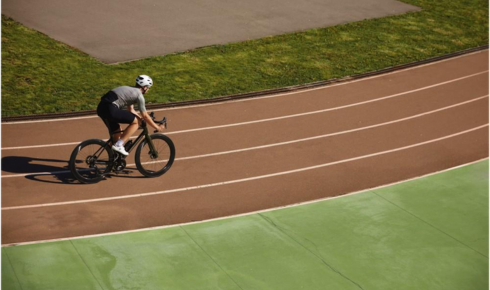Cycle tracks and walking tracks are becoming essential components of modern urban infrastructure, promoting healthy lifestyles and providing safe spaces for exercise and commuting. Whether in parks, residential complexes, or public spaces, the choice of cycle track flooring and walking track flooring plays a crucial role in durability, safety, and user experience.
In this blog, we’ll cover everything you need to know about synthetic walking track and synthetic cycle track flooring materials, sizes, prices, and construction considerations, helping you make informed decisions for your next project.
Why Synthetic Flooring is the Ideal for Cycle and Walking Tracks
Traditional track surfaces like concrete and asphalt have served well but come with drawbacks such as hard impact on joints, quick wear under heavy use, and limited design flexibility. This is where acrylic flooring and other synthetic materials offer significant advantages.
Benefits of Synthetic Cycle Track Flooring Materials
- Enhanced Durability: Synthetic materials withstand heavy foot and cycle traffic, as well as harsh weather conditions, without cracking or degrading.
- Improved Safety: Cushioning layers in synthetic floors reduce impact stress on joints, minimizing injury risk for runners, walkers, and cyclists.
- Weather Resistance: These materials resist UV rays, rain, and temperature fluctuations, making them ideal for outdoor use.
- Customizable Designs: Synthetic flooring allows for color coding, lane markings, and branding to enhance track visibility and aesthetics.
- Low Maintenance: Unlike asphalt or concrete, synthetic surfaces require minimal cleaning and occasional resurfacing to maintain quality.
Cycle Track Size and Walking Track Size
Proper sizing is crucial for safety and usability. Here’s what you need to know:
- Cycle Track Size: Typical cycle tracks are between 2 to 3 meters wide for single lanes, with multi-lane tracks extending up to 5 meters or more depending on traffic volume. Width should allow safe passing and accommodate various cycling speeds.
- Walking Track Size: Walking tracks usually range from 1.5 to 2.5 meters wide, depending on expected foot traffic. Tracks in public parks or residential areas tend to be wider to accommodate groups and ensure comfort.
Adequate lane widths prevent overcrowding and accidents, ensuring smooth flow and user satisfaction.
Understanding Cycle Track and Walking Track Flooring Price
Budgeting accurately for track flooring helps avoid surprises during project execution. Both walking track flooring price and cycle track flooring price depend on several factors:
- Material Quality: Premium acrylic and polyurethane synthetic flooring materials cost more upfront but provide longer lifespan and better performance.
- Track Size: Larger track areas increase the volume of materials and labor required.
- Base Preparation: Proper base leveling, drainage systems, and sub-layer installation add to costs but are essential for longevity.
- Design Complexity: Multiple lane markings, color variations, and logos may increase installation expenses.
- Installation: Professional installation ensures the surface meets all safety and durability standards.
Typical pricing in India ranges from ₹500 to ₹1,200 per square meter for high-quality synthetic track flooring, though prices vary based on specifications and location.

Choosing the Right Walking Track and Cycle Track Construction Company
Selecting a skilled walking track construction company or cycle track construction company can make a huge difference in the final quality of your track.
Key qualities to look for include:
- Proven expertise in synthetic cycle track flooring materials and installation
- Experience with site-specific challenges such as soil type, drainage, and weather conditions
- Ability to provide turnkey solutions, including base preparation, flooring, and line markings
- Positive references and portfolio showcasing successful track installations
- Commitment to timely project completion and post-installation support
Working with professionals ensures your track will be safe, durable, and compliant with international standards.
Materials Used in Cycle Track and Walking Track Flooring
The choice of flooring materials directly impacts performance, safety, and maintenance.
- Acrylic Flooring: The most popular synthetic option for both walking and cycle tracks, acrylic floors offer excellent UV resistance, slip resistance, and color retention.
- Polyurethane Surfaces: Known for superior cushioning, polyurethane is often chosen for high-impact walking tracks where joint protection is a priority.
- Rubberized Flooring: Sometimes used in walking tracks for its natural shock absorption, but less common for cycle tracks due to wear concerns.
- Hybrid Synthetic Systems: Combining layers of acrylic and polyurethane, these systems provide a balance of durability and comfort.
Each material can be customized with textures and finishes to optimize grip and water drainage, ensuring safe conditions in all weather.
Maintenance Tips for Synthetic Cycle and Walking Track Flooring
To maximize the lifespan of your synthetic track flooring, regular maintenance is essential:
- Routine Cleaning: Sweep and wash the surface periodically to remove dirt, leaves, and debris.
- Surface Inspections: Check for cracks, peeling, or wear spots annually.
- Prompt Repairs: Address minor damages early to prevent escalation.
- Avoid Harsh Chemicals: Use mild cleaning agents to preserve material integrity.
- Control Heavy Equipment Use: Prevent unnecessary wear by restricting heavy vehicles or machinery on the track.
With proper care, synthetic tracks can last 8-12 years or more without major resurfacing.
Conclusion
Choosing the right cycle track and walking track flooring materials and partnering with an experienced construction company ensures your facility delivers superior performance, safety, and aesthetic appeal. Synthetic flooring, especially acrylic-based systems, offers unmatched durability, weather resistance, and comfort—making them the ideal choice for modern urban infrastructure.
Understanding key aspects like track size, flooring price, and material options empowers you to make the best decision for your project. Whether for a public park, sports complex, or residential area, investing in premium synthetic flooring guarantees a long-lasting, user-friendly track that promotes healthy living and outdoor activity.

